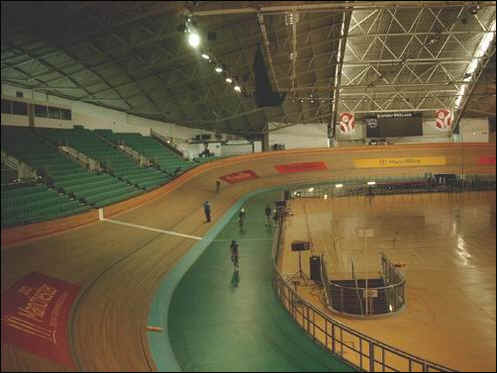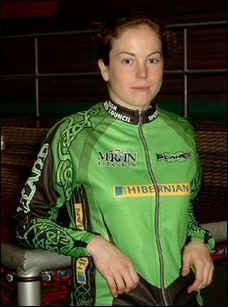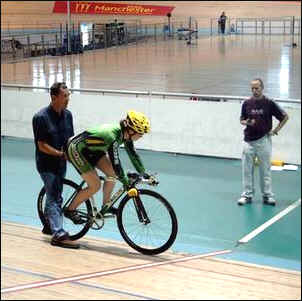Track Cycling Ireland |
|
Page 2Flashback: June 21st. Arriving at the Manchester velodrome, the first thing which impresses is the sheer size of the venue. A huge structure situated near the new Manchester City grounds, the track is easily accessible and built to exacting standards, earning the reputation as one of the fastest and best velodromes in the world.
Walking in the door and over to the perimeter railings, the steepness of the track is a shock to the system. This is nothing like the Sundrive Road venue in Crumlin; the corners yawn up at a 45 degree angle, creating a considerable drop down into the centre section. Black rubber streaks mark the point where riders and bikes slid down the banking, leaving bits of tyres, skin and pride on the boards. Phil Collins draws attention to one angry scar which marks the point where Declan Lonergan hit the deck years previously. He also points out the railing at the top of the first banking where a rider shot up the track, hurtled into the barrier and was unceremoniously catapulted over into a wall. ‘He jumped up straight away and waved to the crowd…some of those sprinters are a bit crazy,’ says Collins. The session starts with the Irish riders doing a progressive warm-up. Chris Boardman and Terry McManus stand down at track edge, sending the riders off in little groups and between them blowing a whistle which indicates a gradually-increasing pace. The riders swish by on their new, custom built, green Terry Dolan track machines, which glide by silently on the smooth wooden boards. Immediately apparent is their improved bike position; each rider looks both aerodynamic and efficient, cleaving through the air as they pedal with growing speed around the track. Paul Healion and Louise Moriarty appear particularly low, but every rider looks the part. It is clear that a lot of thought and effort has gone into this 22 week preparatory period. Each rider works out for a total time period of over two hours, at times riding together and on other occasions concentrating on matters efforts specific to their individual B world disciplines. Keith Bannan and Paul Doyle practice some jumps, Paul Healion, Paddy Moriarty, his sister Louise and Rebecca O’Connell ride several laps at, or above, pursuit pace. Ray Clarke does some flying-start kilometre efforts and Gillian McDarby and Sarah White do some sprints and speed work. Throughout the exercises, Chris Boardman and Terry McManus take notes, shout encouragement and give riders advice and guidance. The net effect is a hard working group which appears willing to give its all in the effort to learn and improve. Off the track, the signs are good too. The banter and bonding within the group is clear to see, with riders pulling together and giving an overriding feeling of team unity and co-operation. And despite what is obviously some very hard, physically draining work, they come across as a collection of people who are enjoying the experience and challenge. ‘The group is amazing, they give everything you ask of them and click together so well,’ Collins later says. ‘We didn’t have a very big pool of people to chose from but to tell you the truth, even if there had been many more, we couldn’t have asked for a better combination. There has never been a group of Irish track cyclists more up for it, who have worked harder or gelled together so well. I know every single one of them will give their absolute utmost in their events.’
‘Part of it, though, is down to Chris, Terry and Phil, and the way they have built things. They have done a huge amount over the past few weeks. Chris and Terry handle the coaching, in so much as Chris gives the overview and Terry does the hands-on stuff. Phil has done all the logistics and is the manager. Phil has done Trojan work..I am sure we don’t see half the work he does. He has organised all the bikes and equipment, the planning, the hotels..everything. The whole setup is definitely more professional than I have ever seen before.’ Speaking two weeks before the start of competition, Moriarty stated that the exercise was a bit of a leap in the dark. ‘We haven’t raced at this level before – in fact some of us haven’t really done any track racing. So we don’t know what to expect.’ For that reason, coach Terry McManus was focussing on getting the riders to do their utmost, in terms of preparation and on the actual day of racing itself. ‘The whole thrust of this project is to get the riders to be the best they can be on a particular day’, he explained. ‘That’s what this is about. You can’t control what the outside competition is going to be like, so the riders must only focus on what is within their control. When they look back they will be able to say “yes, I did everything I could possibly do to get here, and get the most out of myself.” That is the whole thrust of this.’ ‘How things began is that Phil identified the group of athletes and approached me to get involved because of what I was doing (studying exercise physiology) and also because of my own background in racing’. ‘It has been a great experience. All the riders have shone in one way or another. It is a privilege to work with so many different personalities in the group and that is a real challenge. The mind of each person works so differently, but we have managed to get them to gell together as a group. The team spirit is very good…I think initially it was quite difficult as we weren’t sure who would make the team. But once we had that decided, we had one or two trips away which were very good. They riders actually exchanged information no end, which is rare in cycling….traditionally people wouldn’t talk about what training they do or what works for them. So we have learned a lot from the riders themselves’.
The process has been a learning experience for everyone, Boardman included. ‘My brief was to help create a Cycling Ireland cycling team from scratch,’ he explains. ‘When I first got involved we had no coaches, we had no riders, we had nothing. We had just Phil Collins’ idea, his concept to start this off and do it properly from the word go.’ ‘For me it was like a course, really, to teach coaches, management and athletes how to structure a career, how to train – all the elements to get the rider to an event and help them to be as fast as they can be. We had just a few months to do it and the examination of the course, if that’s how you want use that term, is the B world championships, the Olympic qualifying event. That’s how I see it…all these riders have been on a training course, as much as they have been on a physical coaching thing. To learn how to be an athlete, to learn how to manage a career, to learn how to structure it, how to train, how to solve problems – ultimately that is what training is. It is just about solving a problem, albeit a physical one.’ ‘We looked at the individual demands of the disciplines. Take a sprinter, for example. I’m no sprinter but we have been coaching sprinters here, because we said “right, what are the attributes someone needs for the sprint events”. We broke it down into its component parts, we looked at what those attributes were which a sprinter needs and then we said right, how are we going to create that? It has just been a seven month training programme.’ ‘Everybody has come on in leaps and bounds. We have got Rebecca O’Connell, who has literally come from riding to work on a bike and then starting to ride races at the weekends. She has one year of riding bike races – she has probably done half a dozen bike races in her life. She is now going to a world championship…she actually came into the programme late and adapted really well. I can see the potential she has for one, two, three years to perform on the world stage, if that is the direction she wants to go. She has a natural style on the bike, technically she is very good and is very stable. Even when she is very, very tired she can hold her line very well on the track.’ Boardman believed that many of the squad had potential as track riders, and felt that the exercise would prove to be of benefit to them. ‘For example, Paul Healion has started to fulfil some of the potential that people have seen in him over the past few years. This project has taken a fairly well experienced cyclist and to help focus his energies into a more productive way of working. He has moved on perhaps 15 seconds in the pursuit so you can see that he has really moved forward.’ ‘Whatever happens in Switzerland - and I do think there will be some good results - I think a facility is necessary to move forward from where we are at now. These guys have trained on the road for a track event! This is the second time they have been to a proper track. It is really stretching it to call Sundrive Road a proper track, in its current condition. There are no lines on it, there are holes on it, there are people throwing bottles over. I mean, I trained on Kirby but Sundrive was challenging, to say the least! So they have had nothing – they have literally had a few days on a proper track, and that has been it. We have gone on and dealt with that, but if you want better results, if you want to go forward again then they need at least a cycle track. It is a bottom line, really. The riders need to get a proper track, but from what I understand, that is already at hand (re the recondition of Sundrive road) and that is quite an exciting prospect.’ Other Pages <Page 1, Page 2, Page 3, Results> <Read More by Shane Stokes Here> |

 Louise
Moriarty agrees with Collins about the chemistry of the group. ‘The atmosphere
is really, really good’, she says, between stints on the track. ‘I think
there is a really good balance in the squad. There is no-one who is really
egotistical. You have got the balance of Keith Bannan and Paul Doyle, who are a
little more older but who have a really good sense of humour, and then the rest
of us who are a little bit younger. I don’t know why but it just works really
well. I think part of it is that we all have our own events…it is not like in
a road race where we are all in the same competition, and even though you are a
team, you are sort of competing against each other as well.’
Louise
Moriarty agrees with Collins about the chemistry of the group. ‘The atmosphere
is really, really good’, she says, between stints on the track. ‘I think
there is a really good balance in the squad. There is no-one who is really
egotistical. You have got the balance of Keith Bannan and Paul Doyle, who are a
little more older but who have a really good sense of humour, and then the rest
of us who are a little bit younger. I don’t know why but it just works really
well. I think part of it is that we all have our own events…it is not like in
a road race where we are all in the same competition, and even though you are a
team, you are sort of competing against each other as well.’ One of the most crucial factors of the project has
been the input of Chris Boardman, who was taken on to act as an expert advisor
to the group. The Wirral rider has a massive amount of experience in the area,
having won Olympic gold in the pursuit in 1992, taken three world hour records
on the track and also world championship gold. He also had a very successful
professional road race career with three Tour de France prologue victories and a
gold medal in the world time trial championships and this history, coupled with
his interest in physiology and training methods, was vital if the team was to
get ready in time for the B worlds.
One of the most crucial factors of the project has
been the input of Chris Boardman, who was taken on to act as an expert advisor
to the group. The Wirral rider has a massive amount of experience in the area,
having won Olympic gold in the pursuit in 1992, taken three world hour records
on the track and also world championship gold. He also had a very successful
professional road race career with three Tour de France prologue victories and a
gold medal in the world time trial championships and this history, coupled with
his interest in physiology and training methods, was vital if the team was to
get ready in time for the B worlds.